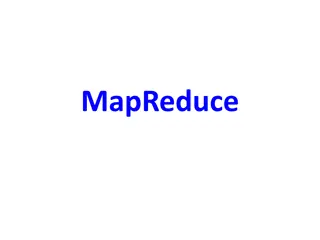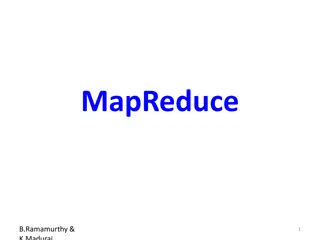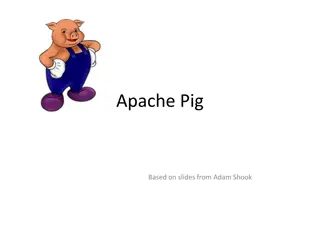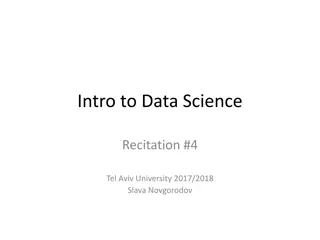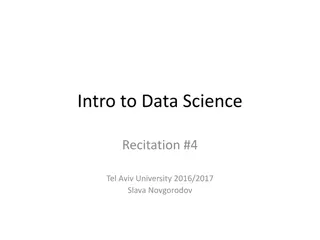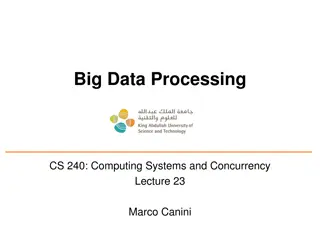Understanding MapReduce System and Theory in CS 345D
Explore the fundamentals of MapReduce in this informative presentation that covers the history, challenges, and benefits of distributed systems like MapReduce/Hadoop, Pig, and Hive. Learn about the lower bounding communication cost model and how it optimizes algorithm for joins on MapReduce. Discover why Google needed a distributed system in 2003, the limitations of special-purpose solutions, and the essential features required for a scalable, fault-tolerant, and easy-to-program distributed system.
Download Presentation

Please find below an Image/Link to download the presentation.
The content on the website is provided AS IS for your information and personal use only. It may not be sold, licensed, or shared on other websites without obtaining consent from the author. Download presentation by click this link. If you encounter any issues during the download, it is possible that the publisher has removed the file from their server.
E N D
Presentation Transcript
MapReduce System and Theory CS 345D Semih Salihoglu (some slides are copied from Ilan Horn, Jeff Dean, and Utkarsh Srivastava s presentations online) 1
Outline System MapReduce/Hadoop Pig & Hive Theory: Model For Lower Bounding Communication Cost Shares Algorithm for Joins on MR & Its Optimality 2
Outline System MapReduce/Hadoop Pig & Hive Theory: Model For Lower Bounding Communication Cost Shares Algorithm for Joins on MR & Its Optimality 3
MapReduce History 2003: built at Google 2004: published in OSDI (Dean&Ghemawat) 2005: open-source version Hadoop 2005-2014: very influential in DB community 4
Googles Problem in 2003: lots of data Example: 20+ billion web pages x 20KB = 400+ terabytes One computer can read 30-35 MB/sec from disk ~four months to read the web ~1,000 hard drives just to store the web Even more to do something with the data: process crawled documents process web request logs build inverted indices construct graph representations of web documents 5
Special-Purpose Solutions Before 2003 Spread work over many machines Good news: same problem with 1000 machines < 3 hours 6
Problems with Special-Purpose Solutions Bad news 1: lots of programming work communication and coordination work partitioning status reporting optimization locality Bad news II: repeat for every problem you want to solve Bad news III: stuff breaks One server may stay up three years (1,000 days) If you have 10,000 servers, expect to lose 10 a day 7
What They Needed A Distributed System: 1. Scalable 2. Fault-Tolerant 3. Easy To Program 4. Applicable To Many Problems 8
MapReduce Programming Model Map Stage map() <in_kn, in_vn> <in_k1, in_v1> <in_k2, in_v2> map() map() <r_k1, r_v2> <r_k5, r_v2> <r_k1, r_v1> <r_k1, r_v3> <r_k2, r_v2> <r_k2, r_v1> <r_k5, r_v1> Reduce Stage Group by reduce key <r_k5, {r_v1, r_v2}> <r_k2, {r_v1, r_v2}> <r_k1, {r_v1, r_v2, r_v3}> reduce() reduce() reduce() out_list1 out_list2 out_list5 9
Example 1: Word Count Input <document-name, document-contents> Output: <word, num-occurrences-in-web> e.g. < obama , 1000> map (String input_key, String input_value): for each word w in input_value: EmitIntermediate(w,1); reduce (String reduce_key, Iterator<Int> values): EmitOutput(reduce_key + + values.length); 10
Example 1: Word Count <doc2, hennesy is the president of stanford > <docn, this is an example > <doc1, obama is the president > < obama , 1> < this , 1> < hennesy , 1> < is , 1> < is , 1> < is , 1> < the , 1> < an , 1> < the , 1> < president , 1> < example , 1> Group by reduce key < obama , {1}> < the , {1, 1}> < is , {1, 1, 1}> < the , 2> < obama , 1> < is , 3>
Example 2: Binary Join R(A, B) S(B, C) Input <R, <a_i, b_j>> or <S, <b_j, c_k>> Output: successful <a_i, b_j, c_k> tuples map (String relationName, Tuple t): Int b_val = (relationName == R ) ? t[1] : t[0] Int a_or_c_val = (relationName == R ) ? t[0] : t[1] EmitIntermediate(b_val, <relationName, a_or_c_val>); reduce (Int bj, Iterator<<String, Int>> a_or_c_vals): int[] aVals = getAValues(a_or_c_vals); int[] cVals = getCValues(a_or_c_vals) ; foreach ai,ck in aVals, cVals => EmitOutput(ai,bj, ck); 12
Example 2: Binary Join R(A, B) S(B, C) < R , <a1, b3>> < R , <a2, b3>> < S , <b3, c1>> < S , <b3, c2>> < S , <b2, c5>> <b3, < R , a1>> <b2, < S , c5>> <b3, < R , a2>> <b3, < S , c1>> <b3, < S , c2>> Group by reduce key S R <b3, {< R , a1>,< R , a2>, < S , c1>, < S , c2>}> <b2, {< S , c5>}> b3 c1 b3 c2 a1 b 3 b a2 3 <a1, b3, c2> <a1, b3, c1> No output <a2, b3, c1> <a2, b3, c2> 13
Programming Model Very Applicable Can read and write many different data types Applicable to many problems distributed grep distributed sort term-vector per host document clustering machine learning web access log stats web link-graph reversal inverted index construction statistical machine translation Image processing 14
MapReduce Execution Master Task Usually many more map tasks than machines E.g. 200K map tasks 5K reduce tasks 2K machines 15
Fault-Tolerance: Handled via re-execution On worker failure: Detect failure via periodic heartbeats Re-execute completed and in-progress map tasks Re-execute in progress reduce tasks Task completion committed through master Master failure Is much more rare AFAIK MR/Hadoop do not handle master node failure 16
Other Features Combiners Status & Monitoring Locality Optimization Redundant Execution (for curse of last reducer) Overall: Great execution environment for large-scale data 17
Outline System MapReduce/Hadoop Pig & Hive Theory: Model For Lower Bounding Communication Cost Shares Algorithm for Joins on MR & Its Optimality 18
MR Shortcoming 1: Workflows Many queries/computations need multiple MR jobs 2-stage computation too rigid Ex: Find the top 10 most visited pages in each category Visits UrlInfo User Url Time Url Category PageRank Amy cnn.com 8:00 cnn.com News 0.9 Amy bbc.com 10:00 bbc.com News 0.8 Amy flickr.com 10:05 flickr.com Photos 0.7 Fred cnn.com 12:00 espn.com Sports 0.9 19 19
Top 10 most visited pages in each category UrlInfo(Url, Category, PageRank) Visits(User, Url, Time) MR Job 1: group by url + count UrlCount(Url, Count) MR Job 2:join UrlCategoryCount(Url, Category, Count) MR Job 3: group by category + count 20 TopTenUrlPerCategory(Url, Category, Count) 20
MR Shortcoming 2: API too low-level UrlInfo(Url, Category, PageRank) Visits(User, Url, Time) MR Job 1: group by url + count Common Operations are coded by hand: join, selects, projection, aggregates, sorting, distinct UrlCount(Url, Count) MR Job 2:join UrlCategoryCount(Url, Category, Count) MR Job 3: group by category + find top 10 21 TopTenUrlPerCategory(Url, Category, Count) 21
MapReduce Is Not The Ideal Programming API Programmers are not used to maps and reduces We want: joins/filters/groupBy/select * from Solution: High-level languages/systems that compile to MR/Hadoop 22
High-level Language 1: Pig Latin 2008 SIGMOD: From Yahoo Research (Olston, et. al.) Apache software - main teams now at Twitter & Hortonworks Common ops as high-level language constructs e.g. filter, group by, or join Workflow as: step-by-step procedural scripts Compiles to Hadoop 23
Pig Latin Example visits = load /data/visits as (user, url, time); gVisits = group visits by url; urlCounts = foreach gVisits generate url, count(visits); urlInfo = load /data/urlInfo as (url, category, pRank); urlCategoryCount = join urlCounts by url, urlInfo by url; gCategories = group urlCategoryCount by category; topUrls = foreach gCategories generate top(urlCounts,10); store topUrls into /data/topUrls ; 24
Pig Latin Example visits = load /data/visits as (user, url, time); gVisits = group visits by url; urlCounts = foreach gVisits generate url, count(visits); urlInfo = load /data/urlInfo as (url, category, pRank); urlCategoryCount = join urlCounts by url, urlInfo by url; Operates directly over files gCategories = group urlCategoryCount by category; topUrls = foreach gCategories generate top(urlCounts,10); store topUrls into /data/topUrls ; 25
Pig Latin Example visits = load /data/visits as (user, url, time); gVisits = group visits by url; urlCounts = foreach gVisits generate url, count(visits); urlInfo = load /data/urlInfo as (url, category, pRank); urlCategoryCount = join urlCounts by url, urlInfo by url; Schemas optional; gCategories = group urlCategoryCount by category; topUrls = foreach gCategories generate top(urlCounts,10); Can be assigned dynamically store topUrls into /data/topUrls ; 26
Pig Latin Example visits = load /data/visits as (user, url, time); gVisits = group visits by url; urlCounts = foreach gVisits generate url, count(visits); Load, Store Group, Filter, Foreach User-defined functions (UDFs) can be used in every construct urlInfo = load /data/urlInfo as (url, category, pRank); urlCategoryCount = join urlCounts by url, urlInfo by url; gCategories = group urlCategoryCount by category; topUrls = foreach gCategories generate top(urlCounts,10); store topUrls into /data/topUrls ; 27
Pig Latin Execution visits = load /data/visits as (user, url, time); gVisits = group visits by url; urlCounts = foreach gVisits generate url, count(visits); MR Job 1 urlInfo = load /data/urlInfo as (url, category, pRank); urlCategoryCount = join urlCounts by url, urlInfo by url; MR Job 2 gCategories = group urlCategoryCount by category; topUrls = foreach gCategories generate top(urlCounts,10); MR Job 3 store topUrls into /data/topUrls ; 28
Pig Latin: Execution UrlInfo(Url, Category, PageRank) Visits(User, Url, Time) visits = load /data/visits as (user, url, time); gVisits = group visits by url; visitCounts = foreach gVisits generate url, count(visits); MR Job 1: group by url + foreach UrlCount(Url, Count) urlInfo = load /data/urlInfo as (url, category, pRank); visitCounts = join visitCounts by url, urlInfo by url; MR Job 2:join gCategories = group visitCounts by category; topUrls = foreach gCategories generate top(visitCounts,10); UrlCategoryCount(Url, Category, Count) store topUrls into /data/topUrls ; MR Job 3: group by category + for each 29 TopTenUrlPerCategory(Url, Category, Count) 29
High-level Language 2: Hive 2009 VLDB: From Facebook (Thusoo et. al.) Apache software Hive-QL: SQL-like Declarative syntax e.g. SELECT *, INSERT INTO, GROUP BY, SORT BY Compiles to Hadoop 30
Hive Example INSERT TABLE UrlCounts (SELECT url, count(*) AS count FROM Visits GROUP BY url) INSERT TABLE UrlCategoryCount (SELECT url, count, category FROM UrlCounts JOIN UrlInfo ON (UrlCounts.url = UrlInfo .url)) SELECT category, topTen(*) FROM UrlCategoryCount GROUP BY category 31
Hive Architecture Query Interfaces Command Line Web JDBC Compiler/Query Optimizer 32
Hive Final Execution UrlInfo(Url, Category, PageRank) Visits(User, Url, Time) INSERT TABLE UrlCounts (SELECT url, count(*) AS count FROM Visits GROUP BY url) MR Job 1: select from-group by UrlCount(Url, Count) INSERT TABLE UrlCategoryCount (SELECT url, count, category FROM UrlCounts JOIN UrlInfo ON (UrlCounts.url = UrlInfo .url)) MR Job 2:join SELECT category, topTen(*) FROM UrlCategoryCount GROUP BY category UrlCategoryCount(Url, Category, Count) MR Job 3: select from-group by 33 TopTenUrlPerCategory(Url, Category, Count) 33
Pig & Hive Adoption Both Pig & Hive are very successful Pig Usage in 2009 at Yahoo: 40% all Hadoop jobs Hive Usage: thousands of job, 15TB/day new data loaded
MapReduce Shortcoming 3 Iterative computations Ex: graph algorithms, machine learning Specialized MR-like or MR-based systems: Graph Processing: Pregel, Giraph, Stanford GPS Machine Learning: Apache Mahout General iterative data processing systems: iMapReduce, HaLoop **Spark from Berkeley** (now Apache Spark), published in HotCloud`10 [Zaharia et. al]
Outline System MapReduce/Hadoop Pig & Hive Theory: Model For Lower Bounding Communication Cost Shares Algorithm for Joins on MR & Its Optimality 36
Tradeoff Between Per-Reducer-Memory and Communication Cost q = Per-Reducer- Memory-Cost Reduce Map key values drugs<1,2> drugs<1,3> Patients1, Patients2 Patients1, Patients3 <drug1, Patients1> <drug2, Patients2> <drugi, Patientsi> <drugn, Patientsn> drugs<1,n> Patients1, Patientsn drugs<n, n-1> Patientsn, Patientsn-1 r = Communication Cost 6500*6499 > 40M reduce keys 6500 drugs 37
Example (1) Similarity Join Input R(A, B), Domain(B) = [1, 10] Compute <t, u> s.t |t[B]-u[B]| 1 Output Input A a1 a2 a3 a4 a5 B 5 2 6 2 7 <(a1, 5), (a3, 6)> <(a2, 2), (a4, 2)> <(a3, 6), (a5, 7)> 38
Example (2) Hashing Algorithm [ADMPU ICDE 12] Split Domain(B) into p ranges of values => (p reducers) p = 2 Reducer1 [1, 5] (a1, 5) (a2, 2) (a3, 6) (a4, 2) (a5, 7) Reducer2 [6, 10] Replicate tuples on the boundary (if t.B = 5) Per-Reducer-Memory Cost = 3, Communication Cost = 6 39
Example (3) p = 5 => Replicate if t.B = 2, 4, 6 or 8 Reducer1 [1, 2] (a1, 5) (a2, 2) (a3, 6) (a4, 2) (a5, 7) Reducer2 [3, 4] [5, 6] Reducer3 [7, 8] Reducer4 [9, 10] Reducer5 Per-Reducer-Memory Cost = 2, Communication Cost = 8 40
Same Tradeoff in Other Algorithms Multiway-joins ([AU] TKDE 11) Finding subgraphs ([SV] WWW 11, [AFU] ICDE 13) Computing Minimum Spanning Tree (KSV SODA 10) Other similarity joins: Set similarity joins ([VCL] SIGMOD 10) Hamming Distance (ADMPU ICDE 12 and later in the talk) 41
We want General framework applicable to a variety of problems Question 1: What is the minimum communication for any MR algorithm, if each reducer uses q memory? Question 2: Are there algorithms that achieve this lower bound? 42
Next Framework Input-Output Model Mapping Schemas & Replication Rate Lower bound for Triangle Query Shares Algorithm for Triangle Query Generalized Shares Algorithm 43
Framework: Input-Output Model Output Elements O: {o1, o2, , om} Input Data Elements I: {i1, i2, , in} 44
Example 1: R(A, B) S(B, C) |Domain(A)| = n, |Domain(B)| = n, |Domain(C)| = n (a1, b1) (a1, bn) (an, bn) (a1, b1, c1) (a1, b1, cn) (a1, bn, cn) (a2, b1, c1) (a2, bn, cn) (an, bn, cn) R(A,B) (b1, c1) (b1, cn) (bn, cn) S(B,C) n2 + n2 = 2n2 possible inputs n3 possible outputs 45
Example 2: R(A, B) S(B, C) T(C, A) |Domain(A)| = n, |Domain(B)| = n, |Domain(C)| = n (a1, b1) (an, bn) (b1, c1) (bn, cn) (a1, b1, c1) (a1, b1, cn) (a1, bn, cn) (a2, b1, c1) (a2, bn, cn) (an, bn, cn) R(A,B) S(B,C) (c1, a1) (cn, an) T(C,A) n3 output elements n2 + n2 + n2 = 3n2 input elements 46
Framework: Mapping Schema & Replication Rate p reducer: {R1, R2, , Rp} q max # inputs sent to any reducer Ri Def (Mapping Schema): M: I {R1, R2, , Rp} s.t Ri receives at most qi q inputs Every output is covered by some reducer Def (Replication Rate): p |I| r = qi i=1 q captures memory, r captures communication cost 47
Our Questions Again Question 1: What is the minimum replication rate of any mapping schema as a function of q (maximum # inputs sent to any reducer)? Question 2: Are there mapping schemas that match this lower bound? 48
Triangle Query: R(A, B) S(B, C) T(C, A) |Domain(A)| = n, |Domain(B)| = n, |Domain(C)| = n (a1, b1) (an, bn) (b1, c1) (bn, cn) (a1, b1, c1) (a1, b1, cn) (a1, bn, cn) (a2, b1, c1) (a2, bn, cn) (an, bn, cn) n3 outputs each output depends on 3 inputs R(A,B) S(B,C) (c1, a1) (cn, an) T(C,A) 3n2 input elements each input contributes to N outputs 49
Lower Bound on Replication Rate (Triangle Query) Key is upper bound : max outputs a reducer can g(q) cover with q inputs g(q)=(q Claim: (proof by AGM bound) 3)3/2 All outputs must be covered: p (q1/2 33/2) p p (qi n3 |O| qi )3/2 n3 g(qi) 3 i=1 i=1 i=1 p p 2 |I| 3n Recall: r = r = qi i=1 r 31/2n q1/2 qi i=1 50





